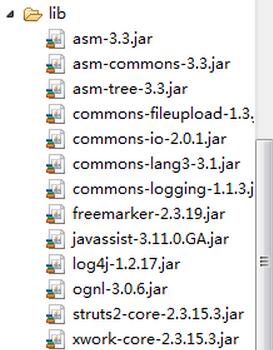本文实例为大家分享了Struts2框架实现文件上传的方法,供大家参考,具体内容如下
struts2的配置过程
(1)在项目中加入jar包

(2)web.xml中filter(过滤器)的配置
|
1
2
3
4
5
6
7
8
9
10
11
12
13
14
15
16
|
<?xml version="1.0" encoding="UTF-8"?><web-app version="2.5" xmlns="http://java.sun.com/xml/ns/javaee" xmlns:xsi="http://www.w3.org/2001/XMLSchema-instance" xsi:schemaLocation="http://java.sun.com/xml/ns/javaee http://java.sun.com/xml/ns/javaee/web-app_2_5.xsd"> <display-name></display-name> <filter> <filter-name>struts2</filter-name> <filter-class>org.apache.struts2.dispatcher.ng.filter.StrutsPrepareAndExecuteFilter</filter-class> </filter> <filter-mapping> <filter-name>struts2</filter-name> <url-pattern>/*</url-pattern> </filter-mapping></web-app> |
(3)struts.xml配置文件的编写
|
1
2
3
4
5
6
7
8
9
10
11
12
13
14
15
16
|
<?xml version="1.0" encoding="UTF-8"?><web-app version="2.5"xmlns="http://java.sun.com/xml/ns/javaee"xmlns:xsi="http://www.w3.org/2001/XMLSchema-instance"xsi:schemaLocation="http://java.sun.com/xml/ns/javaeehttp://java.sun.com/xml/ns/javaee/web-app_2_5.xsd"><display-name></display-name><filter><filter-name>struts2</filter-name><filter-class>org.apache.struts2.dispatcher.ng.filter.StrutsPrepareAndExecuteFilter</filter-class></filter><filter-mapping><filter-name>struts2</filter-name><url-pattern>/*</url-pattern></filter-mapping></web-app> |
(4)action类的编写
|
1
2
3
4
5
6
7
8
9
10
11
12
13
14
15
16
17
18
19
20
21
22
23
24
25
26
27
28
29
30
31
32
33
34
35
36
37
38
39
40
41
42
43
44
45
46
47
48
49
50
51
52
53
54
55
56
57
58
59
60
61
62
63
64
65
66
67
68
69
70
71
72
73
74
75
76
77
78
79
80
81
82
83
84
85
86
87
88
89
90
91
92
93
94
95
|
package com.xmgc.sc.action; import java.io.File;import java.io.FileInputStream;import java.io.FileOutputStream;import java.io.IOException; import org.apache.struts2.ServletActionContext; public class MyUpLoadAction { private String title; private File upload;//与form表单中的file文件类型的名字是一样的 private String uploadContentType;//前缀必须要是上面的upload private String uploadFileName; public String getTitle() { return title; } public void setTitle(String title) { this.title = title; } public File getUpload() { return upload; } public void setUpload(File upload) { this.upload = upload; } public String getUploadContentType() { return uploadContentType; } public void setUploadContentType(String uploadContentType) { this.uploadContentType = uploadContentType; } public String getUploadFileName() { return uploadFileName; } public void setUploadFileName(String uploadFileName) { this.uploadFileName = uploadFileName; } /* public String getSavePath() { //ServletContext cxt=ServletActionContext.getServletContext(); //String path=cxt.getRealPath("/"); //这个获取的path为:http://localhost:8080/sc //上传以后变为E:\software\apache-tomcat-6.0.45\webapps\sc return savePath; } public void setSavePath(String savePath) { //E:\software\apache-tomcat-6.0.45\webapps\sc/myupload this.savePath = ServletActionContext.getServletContext().getRealPath("/myupload"); }*/ public String execute() throws IOException{ System.out.println(title);//标题 System.out.println(uploadContentType);//准备上传的文件的文件类型 System.out.println(uploadFileName);//准备上传的文件的文件名,记住还有扩展名 System.out.println(upload); String realPath=ServletActionContext.getServletContext().getRealPath("/"); String path=realPath+"myupload/"+uploadFileName; System.out.println(realPath); System.out.println(path); FileInputStream fis=new FileInputStream(upload); FileOutputStream fos=new FileOutputStream(path); byte[] bytes=new byte[1024];//定义一个1024大小的字节数组 int len=-1;//用来做标志位 while((len=fis.read(bytes))>0){ fos.write(bytes, 0, len); } return null; }} |
(5)JSP页面的编写
|
1
2
3
4
5
6
7
8
|
<%@ page contentType="text/html;charset=utf-8"%> <!-- enctype="multipart/form-data",这个是最重要的配置 --><form action="myupload.action" enctype="multipart/form-data" method="post"> 文件名:<input type="text" name="title"/><br/> 上传:<input type="file" name="upload"/><br/> <input type="submit" value="上传"/></form> |
经过这次总结,感觉struts2框架下的单文件的上传还是非常简单的,只要获取要存储在什么地方的地址,再通过输入输出流,写到这个地址中去就行了。绝大部分工作,struts2已经帮我们做好了。
以上就是本文的全部内容,希望对大家的学习有所帮助,也希望大家多多支持服务器之家。














